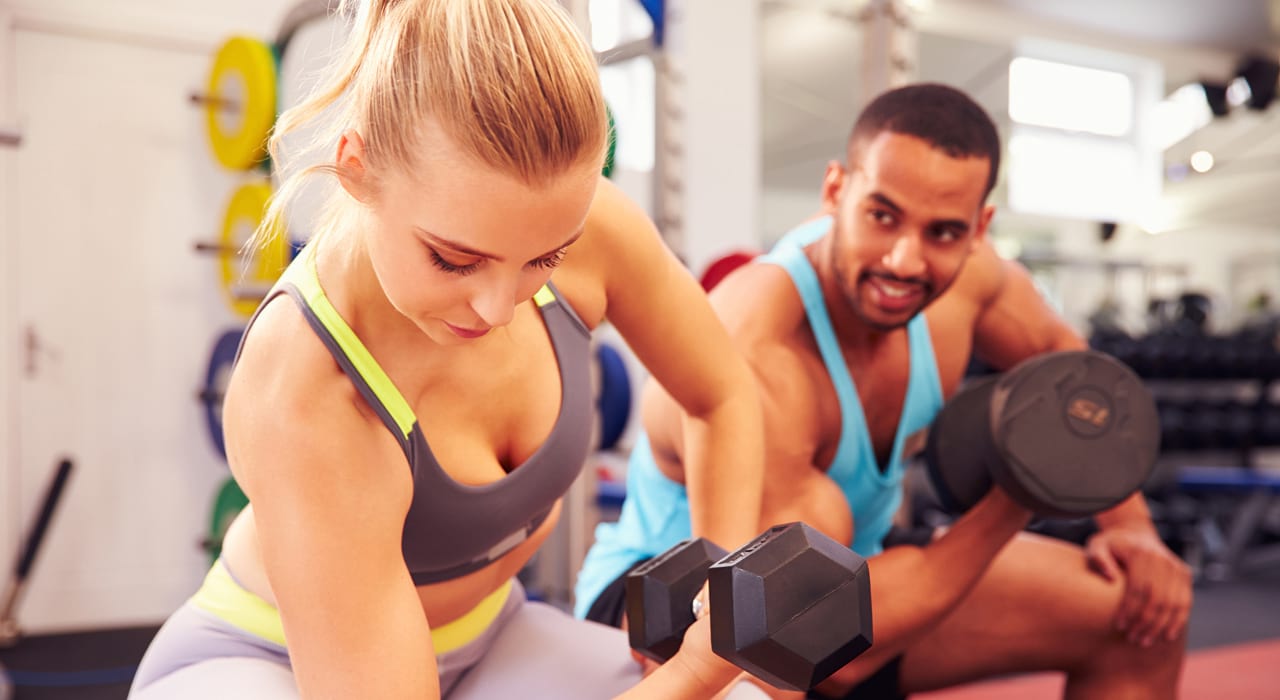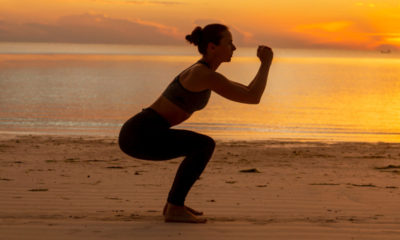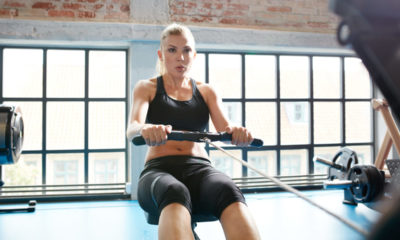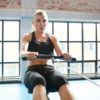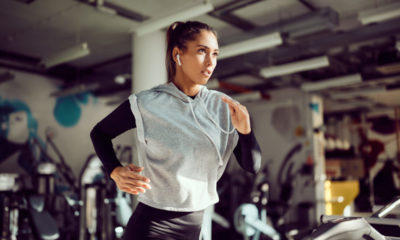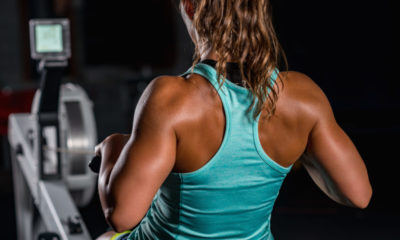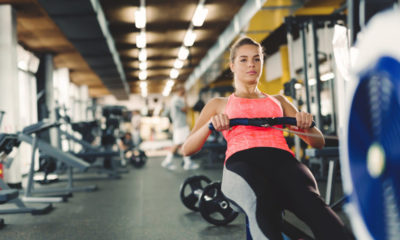Fitness
Should Women Really Be Working Out Differently To Men?
When you train, your goals are pretty much the same as a man’s – get a great-looking, healthy body. Yet the weights room, the place that’ll get you there faster and more effectively, is rarely full of us. In fact, in many gyms it’s rare to see a woman going anywhere near the barbells.
However, lifting weights is easily the best way to change your body. Whether you want to lose weight, sculpt specific body parts or get better posture – weights make it better. So why does lifting remain a man’s domain? Sure, you can get hold of some cute pink dumbbells, but big rusty barbells? Not so easy to find.
Classes aimed at women focus on aerobic exercise, and exercise regimes list slimming and toning as goals, rather than strength. And, despite reams of research showing the benefits of strength training for women, most of us simply don’t sweat it out in the weights room as often or for as long as men.
Anecdotal evidence indicates that at some gyms personal trainers are more likely to focus on the weights room when showing men around, and on the available classes and/or elliptical machines when giving a woman a tour. Now, if the gym were a clothing store, you wouldn’t bat a mascara-laden eyelid about being treated differently. After all, women are shaped differently and have distinctive requirements when it comes to appearance, so of course you expect to be shown the women-only clothes in there.
But in the gym? Should you fight to be treated the same, to be given the same goals and expectations as the guy working out next to you? Or does your body demand a different tailored for- women exercise regime? Here’s the hard science.
Key hormonal differences
The distinctions between you and a guy are visibly evident, but you might be surprised to find that there’s far more to it than curves and body hair. Testosterone, the ‘muscle’ hormone, is the most obvious area in which men and women are very different because the average woman has 6-8.6nanogram per decilitre of free testosterone, while a man has 270-1,100.
Testosterone is required to build lean muscle mass, so if women have less than men, that must mean they produce less muscle, right? Well, not necessarily. Since women are actually more sensitive to the testosterone they have, they don’t need quite as much of it. However, that sensitivity still doesn’t quite make up for the difference in testosterone which is why some trainers argue that because of women’s dramatically lower T-levels they simply can’t achieve the same rate of muscle growth as men. There is research that backs this up.
A study published in Medicine and Science in Sports and Exercise found that strength training produced slightly – but significantly – more muscle volume in men than in women. So men’s genes, which dictate testosterone production, mean that they will naturally pile on more muscle a lot quicker than women.
What does this mean for you as a woman? Well, you’ll need to train even harder to see quick, impressive effects. Luckily for women, that’s not so hard to do because you’re geared to be mentally tougher.
You’re geared for stamina
Sports scientist and entrepreneur Menno Henselmans of bayesianbodybuilding.com has done a great deal of research into studies looking at the differences in the physiology of men and women and this is what he found: “Women’s greater endurance is in part because of their more slow-twitch dominant muscle fibre profiles, which means women are more resistant to fatigue than men, even when you’re comparing men and women of the same strength levels.
“They have more slow-twitch muscle fibres too, which means that to maximize their performance they should do more reps than a guy in each set.”
Despite this kind of evidence, organisations like the American College of Sports Medicine still give the same recommendations to women as men when it comes to how to work out. For example, it recommends that both sexes should do 2-4 sets of 10-25 reps, with a 30-second to one-minute rest period between sets. This is seen as the optimal set-rep-rest ratio to increase muscle endurance.
Though the guidelines are the same, this shows that for the same calorie expenditure, you’ll actually travel further if you were on a bicycle or on a long run. It’s a bit like the tortoise and hare story.
Recovery is your strength
There is strong evidence that women may not need to rest as long between sets as men. Because of women’s greater resistance to euromuscular fatigue and greater muscle perfusion (blood flow), they also recover quicker from a set of reps and even a full training session, Menno suggests, which means that rest times between sets or training sessions can be shorter for women than they need to be for a man.
“Having higher oestrogen levels also sets women apart,” explains Menno. “It aids muscle repair and protects against damage too, so women can train with a higher training volume than men, without the same risk.”
So if you’re sprinting intervals with your significant other, then he may get to the end point faster but you’ll puff and pant less and be ready to go again quicker.
Eat less to go more
Our dietary needs are also different to those of men – an issue that fitness supplement manufacturers should pay more attention to. For example, according to a study published in Medical Science Sports Exercise, women’s metabolisms work so differently from men’s that they actually burn more fat at the same exercise intensity than blokes. Ergo, they don’t have the same dietary requirements as men to fuel their workouts. They can, in theory, eat more fat and may even need less carbohydrate and protein for the same muscle build or exercise intensity.
The bottom line
Certain aspects of a man’s workout may not produce changes in your body that you really want. That doesn’t mean you don’t want to lift heavy. In fact, if you want to see big changes, you have to lift heavy weights, but you might need to adjust which muscle groups you focus on, especially if you want to be strong and healthy and yet still achieve your ideal shape.
So, that might mean you should do fewer exercises that focus on your pectoral muscles. After all, a wider chest is something every man desires, but it’s not usually something a woman aspires towards. That perhaps means doing fewer barbell bench presses, for example, and focusing instead on your shoulders and back.
Similarly, while tree-trunk-sized thighs are something a man might look forward to, as a woman you probably want strong, smooth thighs, but not so big they’ll stretch the seams of your favourite pair of denims. So while you still want to do overhead squats, you might want to do more reps with less weight, for example. That said, there’s every reason for you to hit the weights room alongside the guys.
“Assuming a woman has some exercise experience behind her, she can do a similar programme as that of a man,” explains Shannon.
“Of course, the weights lifted would need to be altered, dependent on her strength level – but she should still challenge herself to lift heavy for her.”
What’s more, one of the primary goals of many women who go to the gym – a slimmer physique – is vastly more achievable if you lift heavy weights regularly. Building muscle means burning more fat, even when you’re not working out, and it’ll also give your body that sculpted shape – the smooth stomach, the taut upper arms and the pert behind.
So put the mini pink dumbbells down and grab that dirty, great big barbell to see some really amazing results faster.
Where you might fall short
So is it all good news for women? Sadly, no. There are some types of exercise that women simply can’t do as well as men, and they include explosive moves like jump squats and clap push-ups.
Men’s nervous systems mean that they can produce extreme force quickly, while women can’t: this means powerlifting will always be easier for a man than a woman, even when they have similar power.
There is one other elephant in the room that men don’t have to deal with – monthly cycles. And if you’re not taking birth control (meaning there’s no hormonal cycle), this does need to be taken into account so you get the most from your workout.
“When a woman is in the follicular phase of her cycle, she will find she has greater endurance and tolerance for pain, so more intense exercise can be performed, focusing on hitting personal bests,” says Shannon Clark (shannonclarkfitness.com), a personal fitness trainer. “She will also be better able to use carbohydrates as fuel at this phase, so this lends well to anaerobic types of exercise. During the luteal phase, she’ll rely more on fat as fuel, so lower intensity, aerobic work may be emphasised.
“Finally, during ovulation, her risk of injury may increase, so she should take care to pay close attention to form.”
Find health and fitness advice in every issue of TRAIN for HER magazine.


